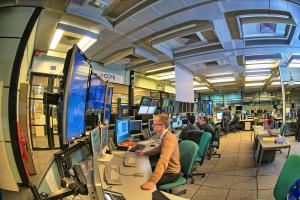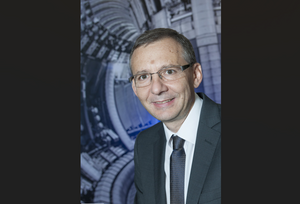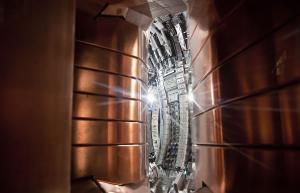Translating JET into ITER
With an inner wall made of beryllium and tungsten, the European tokamak JET is the only tokamak in the world to share the same material environment as ITER. When it begins a new experimental campaign with ITER fuels in January 2021, JET will be a crucial source of experimental data. We asked the head of ITER Physics at EUROfusion¹, Xavier Litaudon, where preparations stand and what we can expect to learn.
The start of the new campaign with tritium and deuterium-tritium mixture is planned in just two months. Can you tell us how the teams are preparing?
JET is now in the final stages of preparing for experiments with tritium and deuterium-tritium (D-T) fuel mixtures. Indeed, important progress on plasma scenario development—as well as the completion of a major program of enhancement in the active gas handling system for the tritium cycle—led the EUROfusion General Assembly, in July 2020, to approve JET readiness for D-T operation unanimously.
Over the past year, significant progress with deuterium plasmas—showing reliable and steady high power operation—has contributed to the development of stationary fusion performance for durations typically lasting 5 seconds, i.e., significantly above the performance obtained previously when JET was equipped with a carbon wall. However, our main objective is to provide good understanding of the consequences for ITER, not just to achieve sustained fusion performance. In this context, progress has also been made in enhancing JET's measurement capabilities in order to deliver high quality data. This data, accompanied by a strong theory and simulation programme so that the underlying physics of the deuterium-tritium plasma can be better understood, means that the JET results will translate to ITER with more confidence.
On the technical side, the commissioning of a critical element for operating JET with tritium—the exhaust detritiation system—was completed during summer 2020. The expansion of the tritium boundary from the active gas handling system² to the JET torus and the neutral beam injection boxes was completed in September, and the commissioning of the heating neutral beams in tritium is now underway. I am particularly impressed by the way the team was able to make all of this progress in the context of a very challenging year, despite the interruption of our campaign in March 2020 due to COVID-19 and subsequent reductions in experimental days per week.
Before entering the D-T phase, JET will begin by experimenting with "pure tritium" plasmas—a first in the history of fusion research. What will these experiments teach us?
The pure tritium experiments will reveal a number of things: how the change of the plasma fuel mass³ will modify the turbulent plasma transport processes in the core and pedestal region; the conditions for the transition from low to high confinement operation (L to H transition); the beryllium wall erosion mechanisms and migration in the scrape off layer to the divertor region; and the divertor detachment under highly radiative plasmas conditions for example. The pure tritium campaign will have a huge impact on the field and on our understanding of the underlying physics of isotope effects. All that is highly relevant for the tritium experiments to come in ITER and in fact in any fusion reactor that wants to run on deuterium-tritium fuel.
Indeed, the development of "pure tritium" plasmas will require an extremely high level of preparation to optimize the use of tritium and to strictly respect the new operation boundary (see next paragraph). In this challenging context, a significant effort has been made to prepare very precise and detailed reference discharges that have been recently rehearsed in pure deuterium (or hydrogen) to reach the required level of reproducibility for pure tritium experiments. Today, thanks to the hard work of the whole JET team, all the reference pulses for repeating in tritium are now available and ready for the coming experimental campaign.
On the operational aspects, the JET safety case limits the amount of releasable tritium inside the vacuum vessel stored on the cryopanels of the pumping system to 11 g. To stay within the set limit, it is planned to carry out daily regeneration (overnight) of all cryopanels, which requires approximately 8 hours. In order to keep up with tritium reprocessing and accounting the campaign will be on a five-week cycle, with three weeks of operation following by one week of tritium reprocessing and one week of tritium accounting. The JET scientists will have to learn to carry out experiments with these new operational challenges. We have already rehearsed best practices in tritium operation by operating with pure deuterium this September. The pure tritium plasma experiments heated with tritium neutral beam power will be executed from the beginning of January up to mid-May 2021, followed by the deuterium-tritium campaign lasting until August 2021 and a subsequent tritium clean-up phase.
Past results on JET have been extrapolated to predict your future campaign, and those results will be extrapolated to ITER. What is the process?
We have computer models, validated using the International Tokamaks Physics Activity (ITPA) worldwide database, of how hot plasmas will behave under certain conditions based both on theory and on previous experiments. We have done much work to validate these models and develop them further, so that now we can routinely predict how future experiments will go. The models include aspects such as plasma turbulent transport, plasma stability, heating and current drive, and the behaviour of fast, hot particles and how that all influences overall performance.
We have used our best modelling tools, developed and validated during more than 20 years on JET, and worldwide databases to prepare and extrapolate our present and future operation. We wish to predict first before carrying out the experiments, both to optimize our experimental development effort and to efficiently guide us on the missing physics that needs to be added if the predictions do not match the observed results. This is the fascinating aspect of our work that could lead to new discoveries and a better understanding of the physics processes. It is not enough to just study isolated process; we want to know how they influence each other so we can catch any non-linear behaviour in our predictions!
Indeed, the physics knowledge of D-T plasmas is still limited and ITER will be essential to making further progress. We have to disentangle all kinds of physics processes. For instance, the change of the fuel mass from deuterium to a mixture of deuterium-tritium, or processes related to the alpha heating effects by the reaction product of the D-T fusion reaction. JET has developed a scientific program where similar discharges in D-D, T-T and D-T will be performed, compared and simulated with the models and codes used to predict ITER performance. If new physics processes are discovered they will be implemented in our modeling suite and the simulation will be compared to the latest experimental results to shed light on the physics of the future burning plasma. This effort will contribute to optimizing the transition from D-D to D-T plasma operation in ITER.
Let's also add that, with this campaign, we have a unique opportunity to educate a new generation of young scientists and engineers that then can be involved in ITER operation in the future. The European experimental team involved in the JET D-T campaign involves more than 300 scientists, 25 percent of whom are from the new generation of scientists (PhD, post-doc, or young engineers) who will also have the opportunity to participate in ITER D-T operation in the future—a unique experience for them!
Lots of things are happening in the fusion world these days, with ITER now well into the machine assembly phase, MAST having just produced first plasma, JT-60 SA close to producing its own, WEST scheduled to launch Phase II in the summer of 2021, etc. As someone who has been involved in fusion research for a long time, how do you feel about this "planetary conjunction"?
Since the start of my career in fusion more than 30 years ago, what I have liked best is that fusion research is a collective and international endeavour. It gives me the reassuring feeling that we can achieve significant progress when we join our efforts in a common goal that could not be achieved individually. The recent groundswell of progress is the result of every actor making a small contribution on a daily and regular basis, with the collective result surpassing individual contributions to produce significant achievements.
So yes, a "planetary conjunction" is possible when worldwide we work together to resolve challenging goals that transcend us. It is a great feeling of happiness for me, especially in the times we're living through because of the pandemic.
¹ JET, based at the Culham Centre for Fusion Energy, is collectively used under EUROfusion's management by more than 40 European laboratories. Some 300 to 350 scientists and engineers from all over Europe contribute to the JET program.
² The active gas handling system stores, supplies and recycles tritium going to and from JET.
³ As the tritium nucleus comprises one proton and two neutrons, a tritium plasma is heavier than a pure deuterium or deuterium-tritium plasma.





